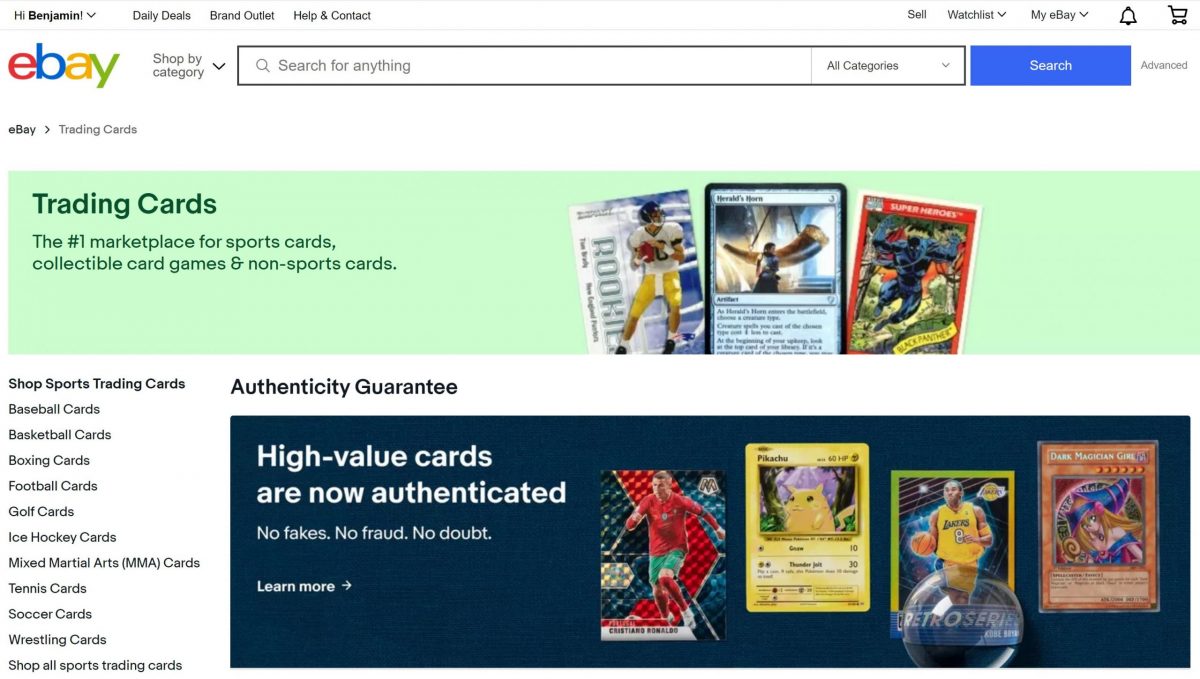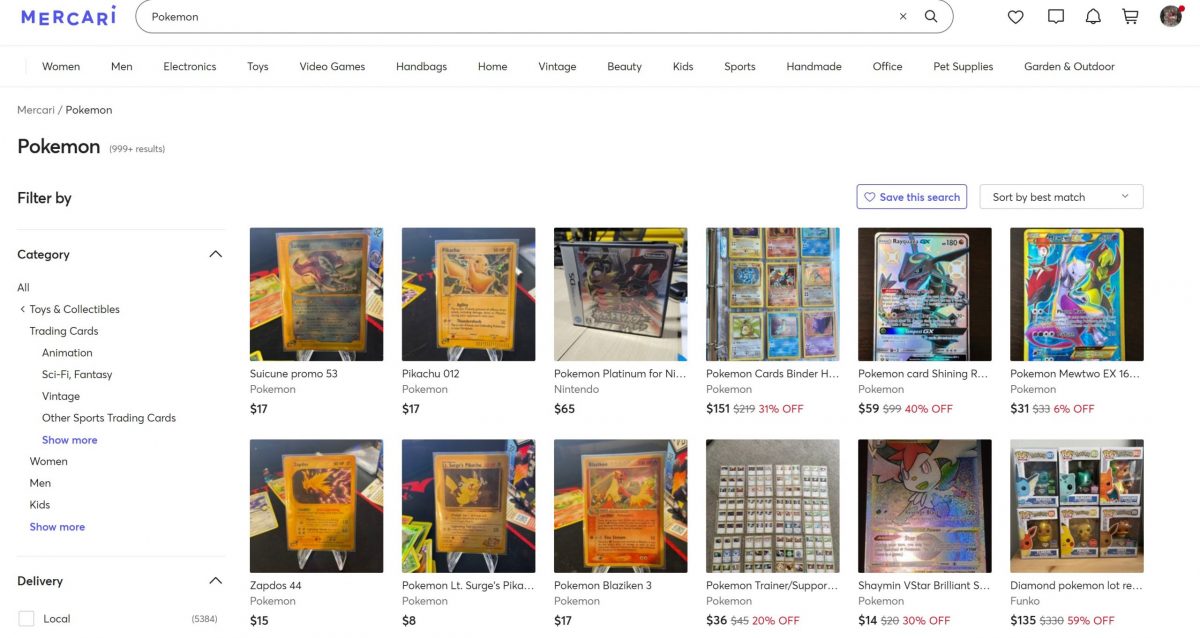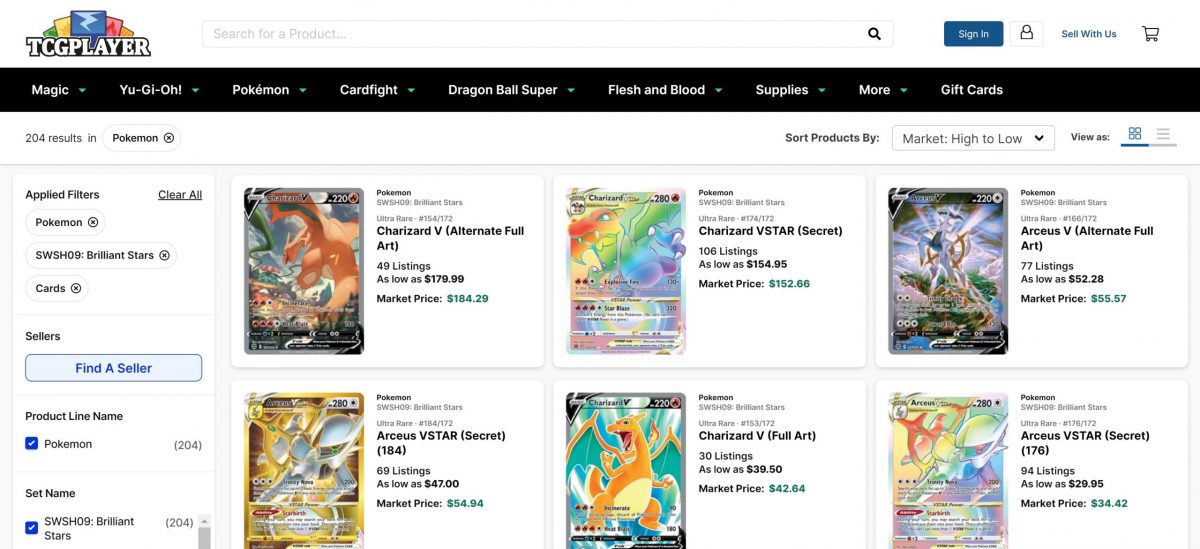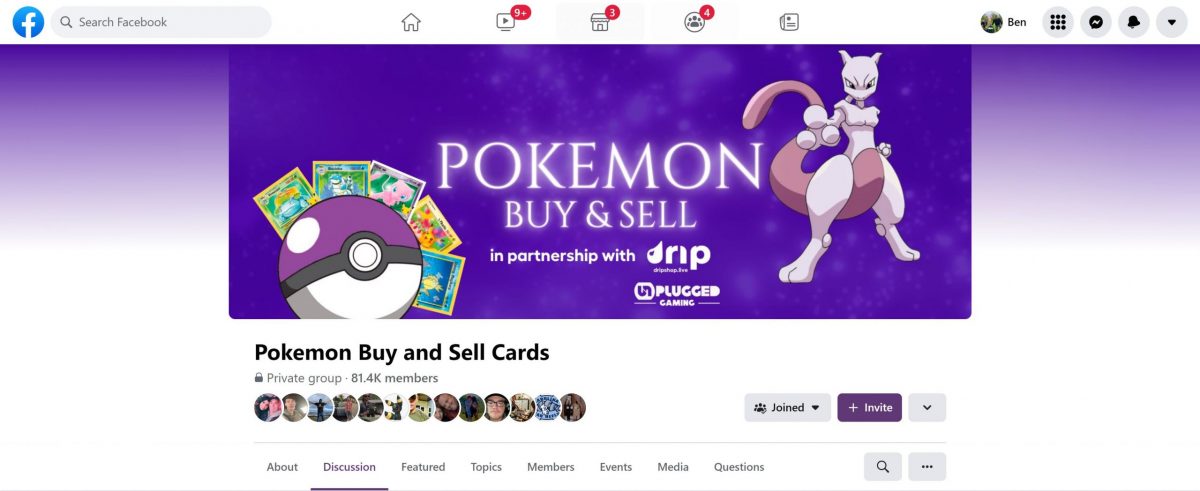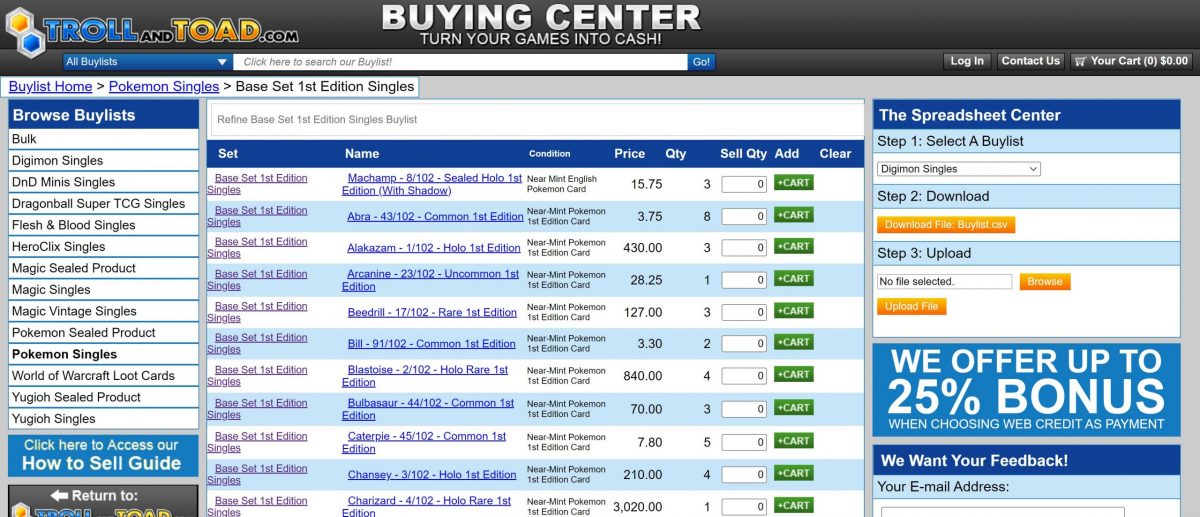10 Best Places to Sell Pokemon Cards for Cash
Our readers always come first
The content on DollarSprout includes links to our advertising partners. When you read our content and click on one of our partners’ links, and then decide to complete an offer — whether it’s downloading an app, opening an account, or some other action — we may earn a commission from that advertiser, at no extra cost to you.
Our ultimate goal is to educate and inform, not lure you into signing up for certain offers. Compensation from our partners may impact what products we cover and where they appear on the site, but does not have any impact on the objectivity of our reviews or advice.
Bulbasaur, Squirtle, Charmander, and Pikachu. They're no less popular today than they were on release back in 1999. Here's how to cash in on Pokemon's sustaining popularity.

Some of the links on DollarSprout point to products or services from partners we trust. If you choose to make a purchase through one, we may earn a commission, which supports the ongoing maintenance and improvement of our site at no additional cost to you. Learn more.
It may come as a surprise to some that Pokemon is the biggest media franchise ever created.
Bigger than Mickey Mouse, Star Wars, Mario, Harry Potter, you name it — it’s bigger than all of them — and really, it’s not even close. As of May 2019, the last time The Pokemon Company released earnings figures, Pokemon was a cool $20 billion clear of the second largest franchise, Hello Kitty ($88.5 billion in revenue since its release in 1974).[1]
Worth noting, this doesn’t take into account that since the pandemic hit in March of 2020, The Pokemon Company has been printing cards non-stop as the demand for the hobby has reached dizzyingly high levels. So high in fact that a Pikachu Illustrator card sold for $5,275,000 this month, and another card, the iconic 1st Edition Base Set Charizard, an astounding $420,000 just last week.
This all begs the question: Are you potentially sitting on a childhood gold mine sitting tucked away in a closet that you haven’t seen in nearly twenty years?
Odds are you likely aren’t sitting on anything worth close to that much, but there are dozens of vintage and modern cards worth hundreds of dollars, even in poor condition.
If you’ve been out of the hobby for a while now and would like to know how to sell your Pokemon cards for cash while the hobby is still hot, I’ll share with you the best places to sell them, some tips for spotting the rare ones, and how to get the most money for them.
Best Places to Sell Pokemon Cards Online
While there are certainly options for selling your cards in person, the best (and most profitable) places to sell Pokemon cards reside online. Most simply this is because online marketplaces have a far wider reach and there’s more opportunity to find deeper pockets.
Our Picks:
- Facebook Groups: Best for Low Fees
- Troll and Toad: Best for Quickly Selling a Collection
1. eBay
Already one of the world’s most known online marketplaces, eBay has intentionally sought to position itself as the premier place to sell Pokemon cards online. Already with millions of cards sold on the platform each year, eBay’s dominance in the space shows no signs of slowing, as Pokemon TCG sales increased 574% YoY from 2019 to 2020.[2]
With a robust array of listing and safety features and access to more relevant buyers than anywhere on the planet, sellers can rest assured knowing they’ll be hard-pressed to find a better place to offload their prized possessions.
- Largest audience of potential buyers (domestic and international).
- Average recent “eBay comps” — also known as comparison prices — are the gold standard in determining the fair market value of a card.
- Organized listing interface for sellers to photograph, describe and list cards.
- Promoted listing options for enhanced listing visibility.
- A more seller-friendly return window was recently introduced (just 3 days).
- The only platform to offer 50% or more total value protection against false or abusive buyer claims.
- Authenticity guarantee for cards valued at $250 or more.
- Helpful tools and templates for high-volume sellers.
- Fees can be on the higher side when compared to alternative platforms; generally around 15% of the final sale value.
- Competing with larger brands in the selling space for organic visibility.
- Listings can be time-consuming to create.
As someone who bought and sold over $100,000 worth of cards on eBay last year, I can attest to the protections eBay offers when compared to alternative selling options. While nearly every place to sell Pokemon cards takes a “buyer-friendly” stance — meaning they default to protecting the buyer during disputes — eBay does the best job of mediating, and will even side with the seller in select circumstances.
2. Mercari
If you’re looking for another good place to sell your Pokemon card collection online, Mercari presents itself as another great choice.
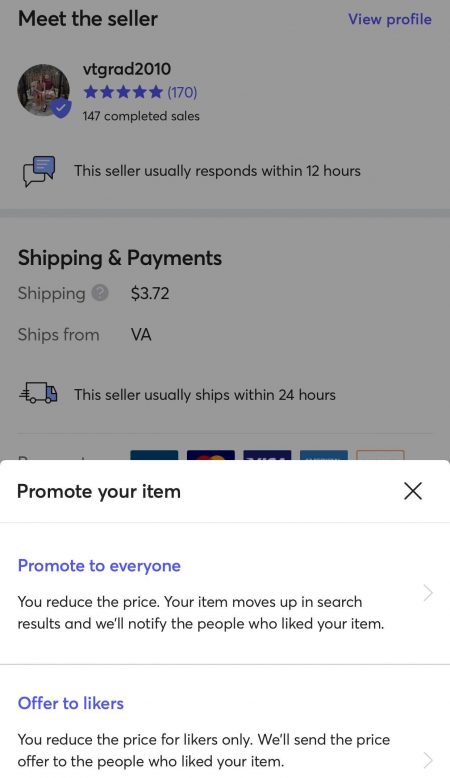
Simply set a price for your collection at a point that you perceive to be slightly above the market value of your cards, and then let Mercari incrementally drop the price until a buyer pulls the trigger.
The promotional setup gives your listing an algorithmic boost each time the price is dropped to bring in fresh new eyes to your listing.
Their floor price feature provides downside protection against your collection selling at a price you’re unhappy with.
If a listing reaches the floor point and still hasn’t converted a sale with no promising leads, merely delete the listing, reassess the market value of your cards, and recreate it for a fresh algorithmic boost.
- Best promotional tools on the market (“Promote to Everyone” and “Offer to Likers”).
- Extremely simple seller user interface (snap pictures, describe, and list).
- Modest seller protections (up to $200 in shipping protection).
- Final sale value is nearly always competing selling platforms.
- No competing with commercial selling enterprises.
- $2,000 upper-end limit on transactions (difficult to sell a valuable collection all at once).
- Only $200 in shipping protection can leave sellers exposed on high-value items.
- No bulk listing tools. Best for single card or entire collection “all at once” selling.
- Domestic shipping only (no international selling).
Read More: Mercari Review 2025: What I’ve Learned After $30,000 in Sales
3. TCGplayer
There are selling apps for flipping everything from clothes and jewelry to tech gear and golf clubs — and then there are apps for selling exclusively trading cards.
That’s where TCGplayer comes in.
The largest niche card marketplace in the world, TCGplayer is widely known for its easy-to-use app and price guide that helps novices and experts alike value their card collections. Like eBay, TCGplayer offers a robust suite of seller tools that are well integrated with their price guide.
While the user interface is a bit cluttered and can lead to information overwhelm, the platform remains an excellent overall tool for gaining access to millions of buyers that may have scorned eBay or other selling platforms. A notable feature, TCGplayer Direct offers an Amazon Prime-like experience for buyers providing them a one-stop-shop for millions of cards and free shipping on orders over $35.
- Largest marketplace exclusive to trading cards in the world.
- Amazon-like experience (trusted sellers get enhanced visibiilty for having a great track record).
- Propietary price guide helps sellers quickly price their cards.
- Research tools show historical price data to spot emerging price trends.
- Domestic and international selling options are available.
- Sales data for high-value cards can be stale.
- Listings rely on accurate seller descriptions and stock photos versus actual product images (can lead to buyer dissatisfaction when the card received doesn’t match the buyer’s mental image of the condition of the card).
- Buy and sell interface can be overwhelming. Learning curve is a bit higher than other selling platforms.
4. Pokemon Facebook Groups
Pokemon-oriented Facebook Groups are undeniably one of the best places to sell Pokemon cards online for two good reasons: low seller fees and high purchase intent.
These groups purely exist for collectors to come together, show off their collections, chat, and of course, buy and sell Pokmon cards. Strict care must be taken to closely follow the rules — every group’s will be slightly different — or you will quickly find yourself dispatched from the community on a permanent basis. Acronyms and seller lingo abounds, so don’t be surprised when it all seems confusing at first.
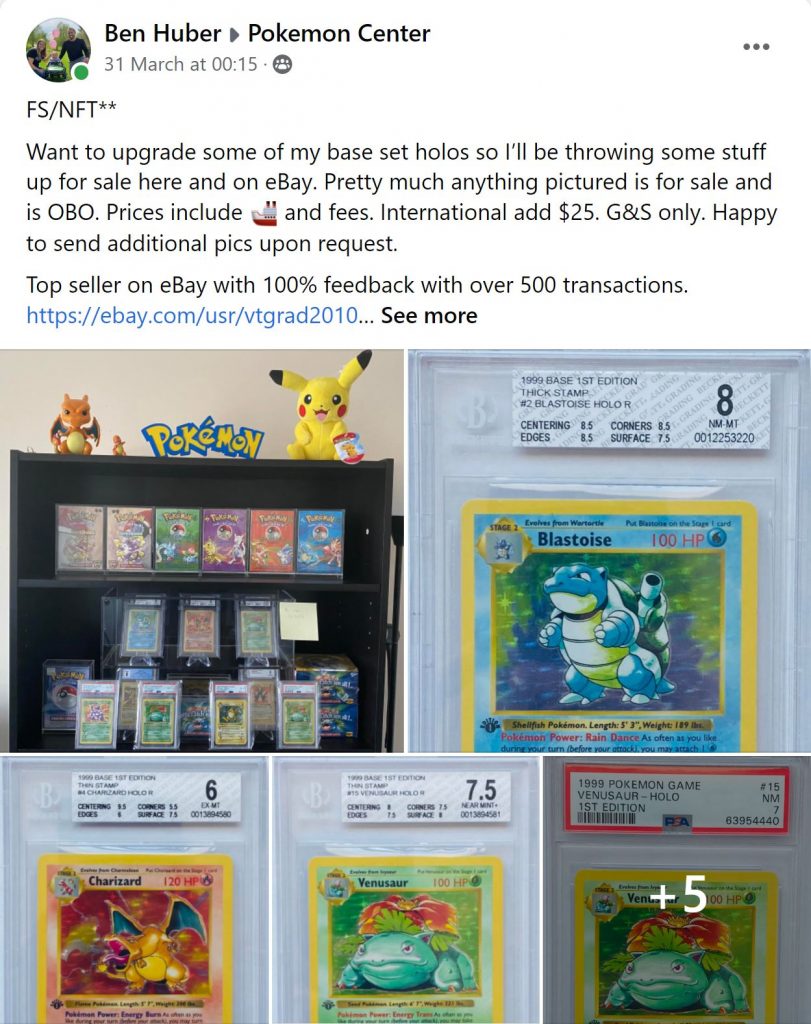
Frequently used terms include:
- FS/NFS: For Sale/Not for Sale
- FT/NFT: For Trade/Not for Trade
- OBO: Or best offer
- G&S: Short for PayPal Goods & Services (the preferred and safest method when paying for cards).
- Pop: Short for population (the number of graded cards in existence).
- ISO/WTB: “In search” of or “want to buy”
- HP, MP, LP, NM, M: Heavy, moderate, or light play; near mint or mint (more on determining card condition below).
The biggest advantage here is the personal component of things. Conversations in the comment sections and/or direct messaging can quickly lead to the sale or trade of cards that might not be publicly listed on the larger exchanges.
- PayPal G&S fees come in at roughly 3.5% of the final sale value; a stark contrast to the near 15% on nearly every other platform.
- Real-time conversations help reduce confusion and easily facilitate the exchange of information (including additional card images).
- High buyer intent (group members are all prospective customers).
- Market value is generally the understood arrangement unless otherwise noted.
- Fewer seller protections, especially if seller accepts payment methods other than PayPal G&S.
- Listing can be tedious and labor-intensive even if selling individual cards, but especially for high-volume sellers.
- Beginner sellers can be more easily scammed.
5. Troll and Toad
Willing to accept a little less money to forego the hassle of photographing, describing, and listing individual cards or entire lots on the major selling platforms? Troll and Toad is for you.
Among the more recognizable names in the industry, Troll and Toad allows sellers to build a “Buylist” of all their cards. Troll and Toad will then specify the quantity of a particular card they’re looking for, along with a cash offer price based on the condition.
Once your card list is finalized, you’ll ship your cards to their headquarters where they’ll vet the condition and quantity. If everything checks out, they’ll issue cash payment within 5 business days. Any discrepancy or overstated card conditions will result in a decreased payout. (There is some leeway here as Troll and Toad isn’t out to nickel and dime people on subjective card condition determinations.)
A noted bonus, Troll and Toad offers a 25% payout boost if a seller decides to receive payment in the form of store credit. If you’re looking to add a holy grail to your collection, this is a great way to instantly get a sizeable discount towards your future purchase.
- Quickly sell an entire collection at just below market value with no research needed.
- +25 % store credit sales boost cashout option available.
- No need to photograph or describe cards.
- Shipping is one and done.
- Cash in hand in about 1 week.
- Won’t get absolute top dollar for your card or collection.
- Prices are fixed with no room for negotiation.
- Responsible for own shipping cost and handling.
Best Places to Sell Pokemon Cards Near Me
While selling your collection online will likely net you the most money, selling your Pokemon cards in person offers the shortest route between you and a paycheck. There may be bit of face-to-face negotiation involved, so a little bit of homework ahead of time can help you set a walkaway point before talks ever start.
6. Facebook Marketplace
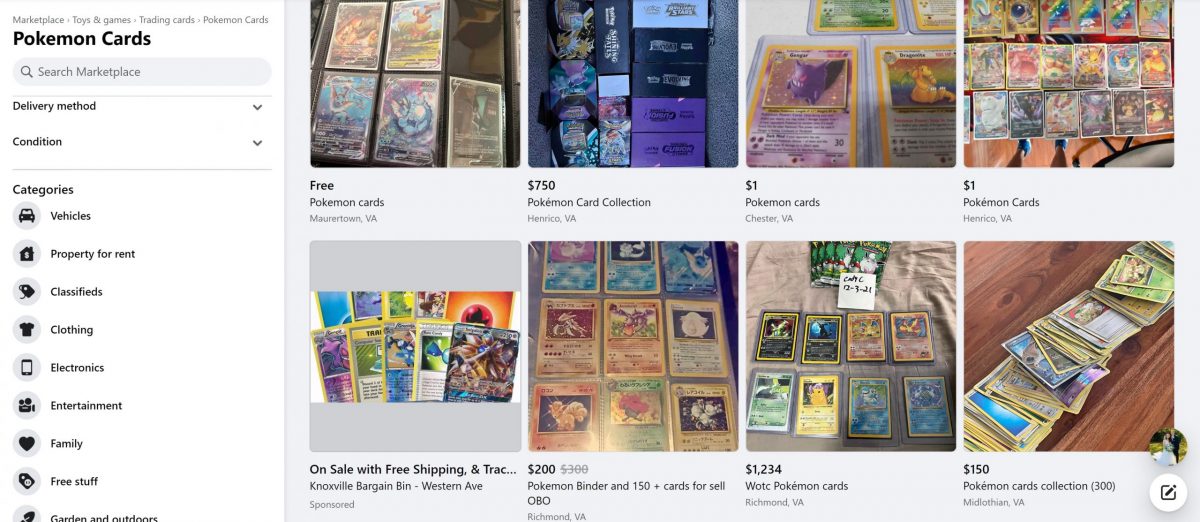
A hybrid online/in-person medium, Facebook Marketplace is the best place to sell Pokemon cards at locations near you.
The biggest perk? There are no listing or selling fees when making an in-person transaction.
Merely create a listing, upload pictures, set a price and all the relevant details, and Facebook’s own Messenger system liaisons between you and interested buyers. Stick firm to your asking price, or shoot a little high knowing buyers are likely to seek out a deal. After a price is agreed upon, set a safe meet location and quickly finish the transaction.
Alternatively, you can set up Facebook Shop, add payment details, and get access to millions of potential buyers across the country. You’ll be charged a 5% transaction fee for each item shipped from your shop, but this vastly undercuts the nearly 15% in fees that eBay, Mercari, and similar digital marketplaces collect.
A small bonus to selling in this way, beyond the low fees, is that your listing is algorithmically pushed to potentially interested parties for free (Facebook is the largest harvester of interest-based information in the world, so this is a pretty big bonus). There’s no need to necessarily “pay to play” as you might have to do on other platforms to gain listing visibility over your competition.
7. Local Card Store
A local card store (LCS) may not necessarily give you the best price on single cards, but there are perks to selling here beyond just the dollar figure acquired. Besides the instant cash payout, building a relationship with your LCS can lead to insider leads on stock dates, a friendly phone call when a card of interest hits the shelves, or even a store credit bonus on sold goods if you think you may make a purchase there in the future.
LCS owners are usually resellers themselves, and will reasonably need to make money off any sort of acquisition they make. Expect offers between 50-70% of the true market value of the item, and don’t be offended when they’re not interested in your bulk cards or the entirety of your collection.
At the end of the day, no one has your best interest in mind other than yourself, so don’t be afraid to come back later in the week once you’ve had a day or two to mull over an offer.
8. Pawn Shop
There’s nothing wrong with needing to make money fast if you’re in a pinch.
If you don’t have a LCS available to you, a local pawn shop offers the next most realistic way to sell Pokemon cards in person quickly.
Again, you can reasonably expect offers here at 30% to 60% of market value, and generally only for higher-end cards. Pawn shops don’t have as targeted a clientele that a LCS would have, so they’ll generally only accept more popular cards so they don’t sit on a shelf forever.
Where to Sell Pokemon Card Bulk
If you’re an enthusiast or collector of any kind, odds are you can spot expensive singles or rare cards amongst a stack of low-value items. And while separating those single cards out and selling them one by one is most often how you’ll make top dollar, getting rid of all your common bulk Pokemon, trainer, and energy cards all at once — for any modest payout — is a win.
Fortunately, there are places that offer fairly generous rates for the low-priced cards you’re no longer interested in. Here are the best places to sell Pokemon card (vintage and modern) bulk.
9. Safari Zone
When I first got back into Pokemon after a nearly 20-year hiatus, I quickly realized that gone were the days of buying a single pack at the store for $3. “Hit” rates — the rate at which a premium card is pulled from a pack — were grossly skewed across a large rarity spectrum, and it takes far more opened packs to nab the rarest cards in modern sets.
This inevitably leads to the acquisition of hundreds, nay thousands, of newly acquired, low-value Pokemon cards sitting on a desk in your house. If you don’t collect master sets, or you find yourself with dozens of duplicate cards, the next thing you’re doing is trying to figure out how to get rid of all of it while getting back a fraction of what you paid for it in return.
That’s where Safari Zone comes in.
They’ll purchase just about any modern card (2003 and onward) from you in exchange for reasonably quick PayPal cash payouts or store credit.
Pay Rates (at time of writing):
- Any Common/Uncommon: $0.02 each
- Any Rare: $0.08 each
- Any Holo: $0.12 each
- Any Basic Energy: $0.01 each
- Any GX: $1.75 each
- Any V: $1.00 each
- VMAX: $1.75 each
- Any Full Art Trainer: $1.00 each
- Any Rainbow Rare: $2.50 each
- Any Gold Rare: $1.50 each
The cards do need to be in near-mint condition and correctly sorted via the categories above. After that, you’ll just package them up and mail them to their bulk submission center. I’ve submitted rather large bulk submissions twice now and each time the process was super easy and I received my cash payout in about 5 business days.
Fill out their bulk submission form to get started.
*Prices are subject to change based on market value and demand.
10. Sell2BBNovelties
While Safari Zone offers some of the most competitive prices on modern Pokemon card bulk, Sell2BBNovelties is one of the few places that accepts vintage Wizards of the Coast set bulk (sets from mid-2003 and earlier).
The standards are somewhat high as they’re looking for mint condition cards, but it absolves the seller the hassle of selling small-time cards for $0.50 on eBay and having to pack them up and ship them out one at a time. Better yet, they can handle all the volume you have, and you’ll get a speedy payout once they process the order and vet the card conditions.
Selling Requirements:
- Cards must be in mint condition (“No bends, creases, scratches, marks, white edges, folds, etc”)
- No foreign or fake cards (English only)
Pay Rates (at time of writing):
- Holos: $0.15 each
- Reverse Holos: $0.05 each
- Rares: $0.04 each
- Commons/Uncommons: $0.03 each
- Energy Cards: $0.005 each (2 cards for $0.01)
Head to their shop to sell your collection.
How to Get Started Selling (Beginner’s Guide)
If you’ve never sold a Pokemon card in your life and know very little about them, you may have a question or two beyond just where to sell them. Below I’ll share several tips for sorting and pricing your cards, and how to get the absolute most money for them.
Sort Your Cards by Set

If you don’t know from which set a particular card comes, Google quickly becomes your best friend.
Merely type in the name of the card and append its corresponding # from the set, which is most often found somewhere near the border on the bottom left or bottom right.
The search results will quickly illuminate the set from which the card originates.
For example, a search for “Bulbasaur 44/102” reveals that the card was released as a part of the original 1999 Pokemon Base Set print run. It is the 44th card in a set of 102 cards.

Sort Your Cards by Rarity
Once you have your cards sorted by set, it’s time to sort them by their printed rarity symbols. The symbols are found in close proximity to the card and set number.
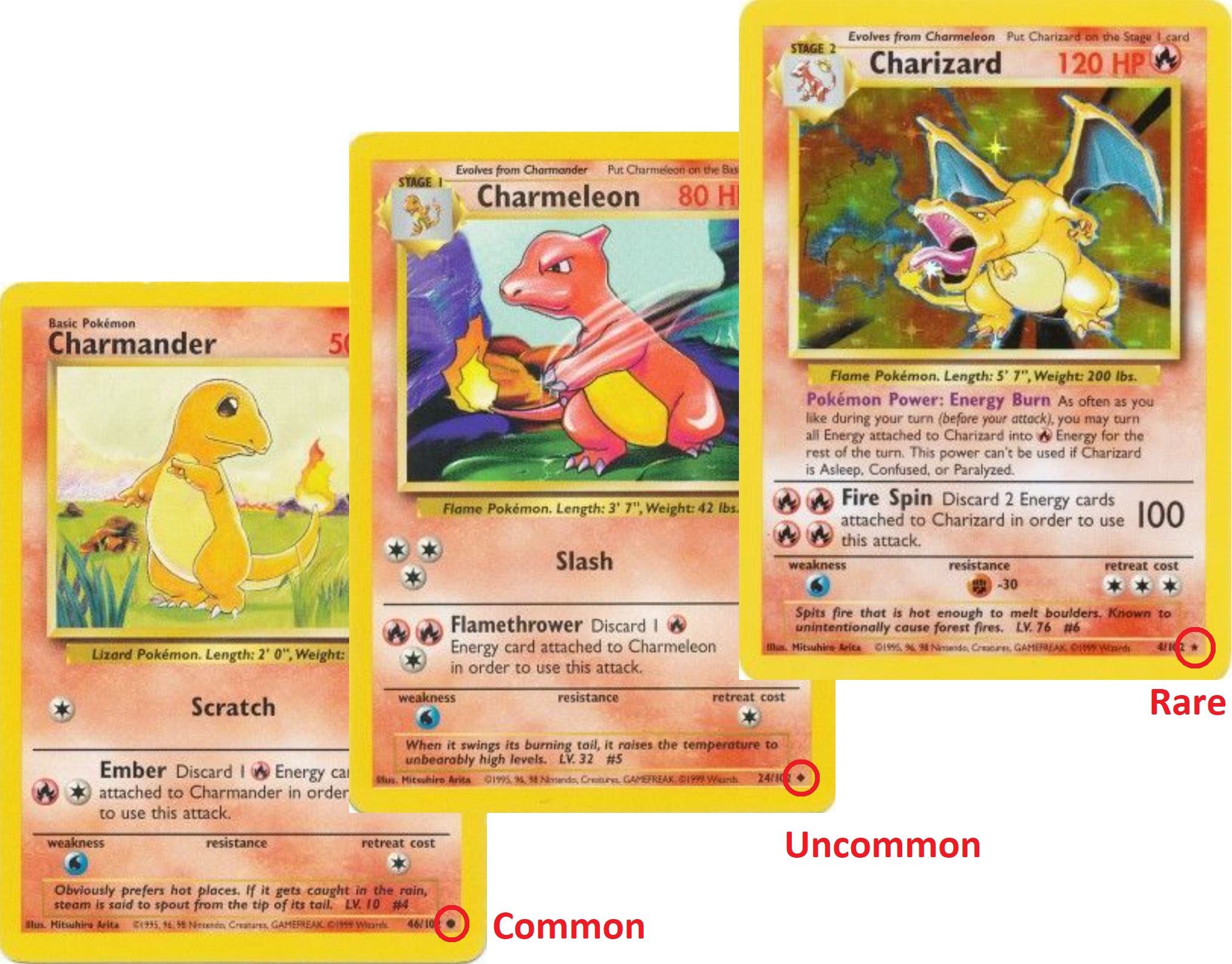
Both vintage and modern Pokemon cards follow this system, so the age of your cards won’t play a role here.
Unfortunately, the symbols can be quite small and are often hard to see, so it may be easier to reference the chart below.
Pokemon Card Rarity Guide
| Symbol | Description | Rarity |
| Star | Rare | |
| Square | Uncommon | |
| Circle | Common |
Now that you’ve got your cards sorted by set and rarity, it becomes a whole lot easier to use one of several available digital price guides.
How to Determine What Your Pokemon Cards Are Worth
While everyone would love to offload their collection for thousands of dollars, sellers need to be realistic about what they’re sitting on and the condition that it’s in. Learning how to assess card condition and pairing that with readily available price data is a prerequisite to getting the most money for your beloved cards.
Assessing Card Condition
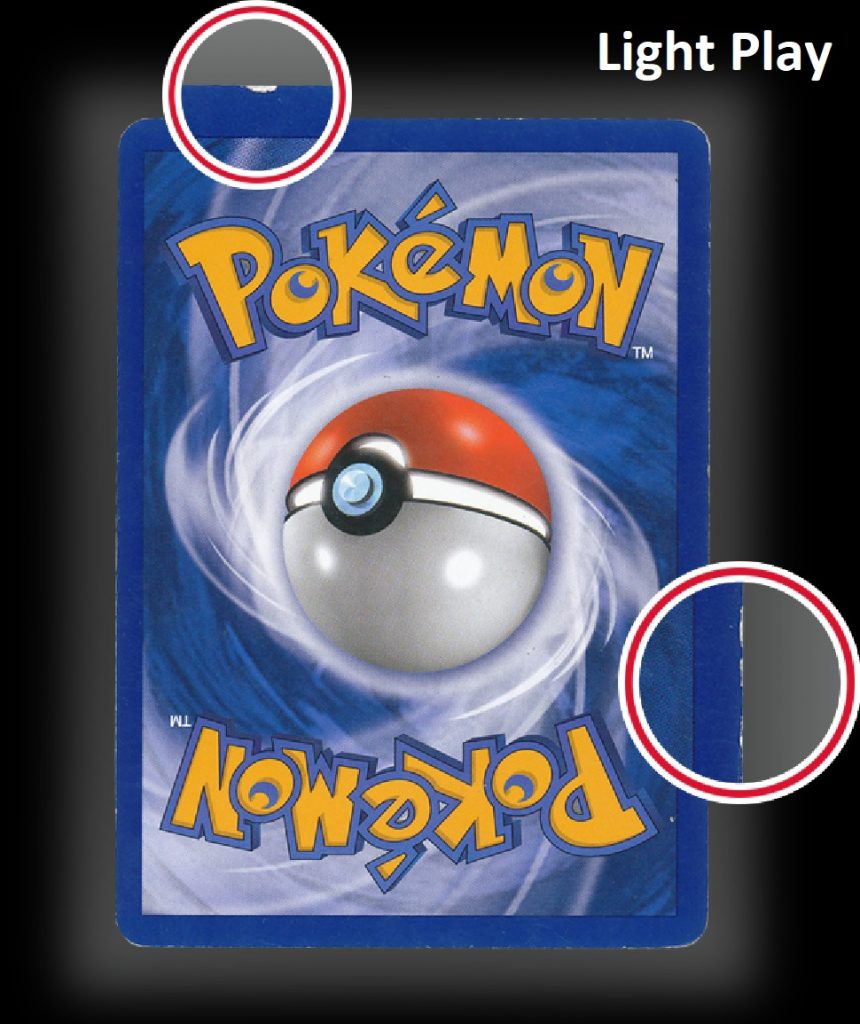
Subjective in nature, accurately determining card condition is an essential skill that one need become proficient at.
A mismatch between the seller-stated condition and buyer assessment can lead to deep dissatisfaction, refund requests, and nasty feedback on public-facing profiles.
Christian at TheGamer does a good job of highlighting the types of damage one should look for when looking at card condition.
Once you have a pretty good idea of how to spot objective types of damage, it makes it easier to make a somewhat accurate determination of the overall condition.
Card Condition Guide
- Near Mint to Mint (NM-Mint) = Few to zero easily detectible imperfections such as nicks on edges, corner whitening, or light surface scratching. For holographic cards, it is generally acceptable to have minor imperfections such as superficial scratching, print lines, or clouding.
- Light Play (LP) = A card in this condition will have several minor imperfections such as nicks, minor scuffing, edge wear, clouding, and/or light scratches.
- Moderate Play (MP) = A card in this condition has significant wear including diffuse edge wear, nicks, scratches, clouding, or scuffs.
- Heavy Play (HP) = A card in this condition is defaced in a way that could make it unplayable in tournaments, even in a sleeve. This damage will include heavy wear such as creases, dents, scratches, bends, scuffs, ink, water damage, clouding, and/or other types of damage.
- Damaged (DMG) = A damaged card is altered in a way that it is most likely unplayable in tournaments, even in a sleeve. This damage may include heavy wear, creases, dents, scratches, bends, scuffs, tears, inking, water stains, and/or other types of damage.
Use Third-Party Websites to Determine Market Value
Once you’ve determined the condition of single cards — or the general condition of an entire set — it becomes much easier to forecast an accurate market value for what it is you’re trying to sell.
TCGplayer has a great set-by-set price guide where you can get a rough idea of the current market value of the card. (Use the drop-down box to change sets). The price information is based on their own marketplace sales history, so there may be little to no data for exceedingly rare cards.
If you believe you have a card that falls into that category, check eBay comps to see if a similar card has sold in the past 3 months. If more than one has sold, take an average of the recently sold listings and try to factor in which direction the market is moving.

If prices have trended upwards recently, it may be wise to add a 5 to 10% market adjustment in response to scarcity or demand. If prices are trending down and you’re motivated to sell, you may need to choose the lower side of the current market value during sale price determination.
Sellers often tend to optimistically overestimate the condition of their cards in hopes of fetching higher sales values. It may be prudent to use a condition “range” like the Sold Venusaur listing shown above. In the listing title, the seller states the card is in LP-NM condition (light play to near mint), with a conservative estimate at one end and an optimistic estimate at the other, helping alleviate perceived condition mismatch between buyer and seller.
Getting Your Pokemon Cards Graded
In the course of researching the market value of your card, you may have come across “graded” cards that seem to be fetching large premiums over cards in seemingly mint condition. This is no fluke.
Over the past 30 years, a number of third-party grading services have popped up to authenticate and grade trading and sports cards. Pokemon cards are certainly no exception. In fact, the multi-six and seven-figure cited examples in the opening paragraph of this article were PSA (Professional Sports Authenticator) graded cards that scored GEM MINT 10 on a condition scale of 1 to 10.
Popular Pokemon Card Grading Services Include:
- PSA (Professional Sports Authenticator)
- BGS (Beckett Grading Services)
- CGC (Certified Guaranty Company)
- SGC (Sportscard Guaranty Corporation)
The paid professional grading insight and card authentication service can cost anywhere from $15 to $500 or more for a single card, but the added value can be well worth it when it comes to sale time.
For example, the 1st Edition Base Set Charizard in mint but ungraded condition would likely have fetched somewhere in the neighborhood of $25,000 to $40,000 on eBay, assuming HD photos highlighted every nook and cranny of the card. The verified authenticity and gem mint status sent the sales price soaring past $400,000, making it only 1 of 121 known cards in existence to have achieved that grade.
That said, card grading requires a small to moderate learning curve, and it may be wise to consult an experienced submitter, check out a YouTube tutorial, or even ask questions in a Pokemon Facebook group before submitting a card(s) to a service.
Best Practice for Sales Listings
As an experienced seller, there are certain tactics I use to almost always get at or even above market value at any of the places to sell Pokemon cards online. A little prep work and attention to detail can help you consistently beat out other sellers for access to buyers and make the most money on your cards, collections, sealed packs, or other memorabilia.
Clean Your Cards
It sounds silly, but it absolutely matters, especially when selling old vintage Wizards of the Coast singles that may have accumulated dirt, dust, and grime. Pokemon cards are famous for accumulating little dark dirt circles that adhere to the back over time.
Simply grab a *very* lightly damp cloth — preferably microfiber — and gently wipe away dirt or deposits in a circular motion. Try to distinguish between dirt and damage before wiping as you can further exacerbate damage if it is already present. Immediately dry the card as moisture will eventually warp its surface.
Take Excellent Photos
Perhaps the most commonly made error in the entire seller universe is uploading absolutely garbage images. Take the time to ensure you have sufficient lighting and a quality camera available to snap decent photos. Almost every modern smartphone has a camera of good enough quality to take excellent photos. Sufficient natural or even added artificial light/flash is encouraged so long as it does not intentionally or unintentionally obscure or hide damage on a card.
You don’t need to overdraw attention to every single flaw, but crisp, sharp images from several different angles that fairly represent the card condition are essential for a successful buy-sell arrangement.
Learn SEO
Each selling platform is a search engine of sorts. Search engine optimization (SEO) helps you design your listing in a way that optimizes how many users end up finding your card or product. Keyword-rich titles and descriptions that maintain relevancy to the potential buyer will help your listing surface in search more frequently on nearly every platform. Here’s a simple eBay SEO guide, the advice from which will translate nicely to just about every other platform.
Pay Attention to Fees
Nothing crushes your potential selling profits faster than fees. It’s why a number of experienced sellers avoid some of the bigger platforms in favor of niche selling on Facebook once they’ve learned the ropes and built a database of fellow collectors over the years. As a beginner seller, or someone who just wants to quickly offload a collection, eBay or Mercari may be your best bet, but it still doesn’t hurt to be cautionary about listing upsells.
Bold font. Second category listing. Subtitles. Disproportional promotion campaigns (when compared to final sale price). They’re all upsells some of the larger companies will offer to pad their bottom line. In some select circumstances, it may be beneficial to use them, but by and large, you’re better off passing on all of it and focusing on a great listing with superb photos and a clean, keyword-rich card description.
(I share several other helpful selling tips here.)
Tips to Avoid Getting Scammed
Like in any selling industry, there are several ways in which, as a seller, you may find yourself SOL. Here’s how to make sure it doesn’t happen to you.
- Only accept official payment methods. Every single one of the best places to sell Pokemon cards for money has rules/accepted ways in which a seller can receive payment. If you frequently flout those rules, it will come back to bite you. More often than not this happens on the buyer side, but sellers aren’t immune either. Chargebacks, fake checks, and gift cards schemes are but a few of the many ways rogue buyers will try and con you out of your cards.
- Meet in a safe space. Police station parking lots or bank lobbies work great, especially for high-dollar transactions (whatever that means to you).
- Cash is king. If meeting for an in-person transaction, cold hard cash is second to none. No fake checks, no chargebacks, no falsified returns, no swapped cards.
- Document everything. If it’s not in writing (or photographed), it never happened. Document everything and take great pictures of anything you sell (including the packaging/shipping process). I’ve had buyers submit bogus returns with fake/replaced cards where I ultimately kept the final sale price/no refund was forced by eBay or any other platform…all because I took comprehensive photos of my pre-shipment process. It only takes getting burned one time for hundreds of dollars to never make this mistake again.
- Be the consummate professional. While nearly every selling platform is “pro-buyer” when it comes to disputes, appeals and/or case reviews are often done by a subject expert that has varying levels of discretion when it comes to rendering a judgement. If your online chat history shows abusive or accusatory behavior, I’d like to think your odds of winning a closely-contested case are not as high as they once were. On several occasions, eBay/Mercari representatives have scrutinized chat history when making a ruling, and anything you can do to tip the scales in your favor is a no-brainer.
At the end of the day, common sense really does go a long way. If something seems off, or there are more red flags than you could possibly shake a stick at, move on. It’s not worth getting burned just to chase a few more dollars.


